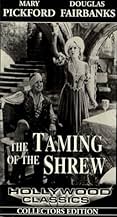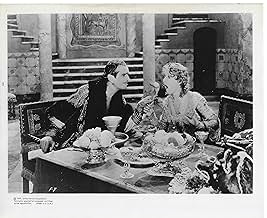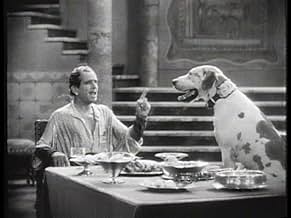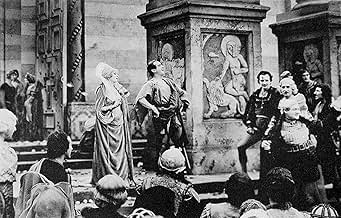In sixteenth century Padua, Hortensio loves Bianca, the youngest daughter of Baptista. But Baptista will not allow the two to get married until his eldest daughter, the extremely headstrong ... Read allIn sixteenth century Padua, Hortensio loves Bianca, the youngest daughter of Baptista. But Baptista will not allow the two to get married until his eldest daughter, the extremely headstrong Katherine, is betrothed. This task seems impossible because of Katherine's shrewish demean... Read allIn sixteenth century Padua, Hortensio loves Bianca, the youngest daughter of Baptista. But Baptista will not allow the two to get married until his eldest daughter, the extremely headstrong Katherine, is betrothed. This task seems impossible because of Katherine's shrewish demeanor. They believe their prayers have been answered with the arrival from Verona of the lust... Read all
- Director
- Writers
- Stars
- Awards
- 2 wins total
- Director
- Writers
- All cast & crew
- Production, box office & more at IMDbPro
Featured reviews
Hollywood royalty Douglas Fairbanks and Mary Pickford star as Kate and Petruchio, the warring couple who really love each other on the sly. Their marriage was a sham by the time this flick came out, and both their careers were on the wane, but they give reasonable enough performances, even though Fairbanks looks a few years too old for his part when the camera gets close. There's still a tendency to exaggerate their gestures and overact to responses to words being spoken, but they're no worse than any other stars making their first sound films.
It's clear that Hollywood back then had no more confidence in the intelligence of its audience than it does today: this is Shakespeare for the common man, with the pith of the Bard's prose removed in order to make the words readily understandable to all. Although the film is little more than an hour long, it does begin to drag during the last twenty minutes but, that aside, it's not a bad effort.
The big problem is that Pickford is so small; when I got my first look at her, she looked like a little girl playing at fancy dress. Taylor stages things so she is equal in height or taller than Fairbanks when they are side by side, but when standing apart she is obviously much shorter. Maybe a match in bad manners, but she is obviously not his physical equal. For example, she is blown about by a high wind in one scene, while Fairbanks is unaffected.
Fairbanks as Petruchio is actually playing one of his swashbucklers, and Pickford as Kate is one of her many spunky waif characters. She does not inspire fear, just a "isn't that precious!" reaction given her size. Notice that when Pickford is supposedly beating up servants and smashing furniture, she does so out of view of the camera, because someone her size would not be capable of doing all of that damage.
The odd thing is that the film looks like great care went into the art direction and photography, and the supporting players are pretty good. Neither Fairbanks nor Pickford have that stiff early talkie way about them, but they are given to wild gestures as though they are still in a silent film. So it is the little things that are done well and with care, while it is the big things that sink the film. I'd give it 5/10 with four of those five going to the physical production design.
The movie was a vehicle for real-life husband and wife Douglas Fairbanks and Mary Pickford, he in his first talkie, she in her second. Given the state that their marriage had degenerated into by this point, the storminess between the two of them probably wasn't that far from the truth. They both act well it has to be said, hamming it up magnificently in a manner drawing upon their experience both in stage and silent cinema, and which you can only really get away with in the context of this play's comical theatricality.
The director is Sam Taylor, a man with a background in comedy, who helmed the finest Harold Lloyd movies during the silent era. The Taming of the Shrew sees him returning to his roots, staging the verbal comedy as broad slapstick. Taylor is a master of the pull-back-and-reveal gag, making us think one thing then punch-lining us with another. In adapting the play, he pares down Shakespeare's dialogue, and reduces it for the most part to a poetic backdrop, allowing the comic vignettes to tell the story. This is quite something, because this style of physical comedy more or less died out when the talkies came along, but here Sam Taylor is showing a way it could have continued.
But what is also intriguingly good about this version of The Taming of the Shrew is its sly subversion of Shakespeare's misogyny. The bard's lines remain what they are, but the action in between them is enough to tweak their message. Pickford is brilliantly sarcastic for Katherine's final speech, and as Fairbanks sits beside her with a large bandage on his head, it becomes clear who's taming whom.
As to the unfaithfulness to the text, the film has Kate overhearing Petruchio's plan to tame her and she then turns the tables on him. Though not Shakespeare, this works in the film. As to faults, I did think Grumio's sneezing fit overlong and the frequent closeups of his reactions throughout the film were annoying. I suppose his part was built up to provide additional comedy, which was unnecessary. Aside from Petruchio's tedious apple core munching, which was Fairbank's idea, much of Shakespeare's wittiest dialog and jokes are intact and just as funny today as they were 400 years ago.
Petruchio really is quite a suitable role for Fairbanks, and his buoyant confidence works well. His portrayal seems to be pretty close to the kind of character that Shakespeare intended. The role of Katherine doesn't give Pickford a chance to use her greatest strengths. She does project good energy, and has plenty of charm when it is called for, but at times her portrayal doesn't seem to fit the original conception of the character, and the role definitely did not give Mary the chance to display her wide range of talents with more subtle material.
The story is a rather loose, jaunty adaptation of the original, and there would be little point in making detailed comparisons. As a movie, most of it works all right aside from the occasional instances of awkwardly-paced dialogue and the like that are characteristic of so many films of the early sound era. Fairbanks does help make some of these moments less noticeable with his obvious good humor. There are certainly a number of obvious ways in which it could have been better, and it's fair to point them out. Yet it still has enough of the classic story, plus enough of its own energy, to make it worth seeing as long as you know what to expect.
Did you know
- TriviaIn her later years, Mary Pickford stated that working on the film was the worst experience of her life, although she also acknowledged that Douglas Fairbanks's performance was one of his best.
- Alternate versionsAfter many years out of circulation, the film was re-released in 1966 in a new cut supervised by Mary Pickford herself. New sound effects were added throughout, much of the voice dubbing was enhanced with newly available technology, and seven minutes were cut from the initial print. This re-released version is the only version now available on DVD or VHS.
- ConnectionsFeatured in Mary Pickford: A Life on Film (1997)
Details
- Release date
- Country of origin
- Language
- Also known as
- The Taming of the Shrew
- Filming locations
- Production companies
- See more company credits at IMDbPro
Box office
- Budget
- $504,000 (estimated)
- Runtime1 hour 3 minutes
- Color
Contribute to this page






























